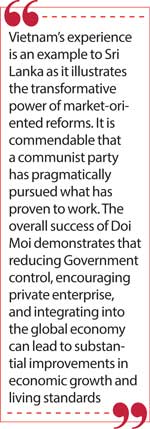Sunday Nov 30, 2025
Sunday Nov 30, 2025
Wednesday, 23 October 2024 00:24 - - {{hitsCtrl.values.hits}}

The Doi Moi reforms were accompanied by a series of pivotal legal changes that facilitated Vietnam’s transition from a centrally planned economy to a market-oriented one
 Introduction
Introduction
The recent Presidential election revealed
substantial public support for a pro-socialist/communist political party.
Sri Lankan Governments over seven decades have been, in general, centrally planning the economy and society. This central planning overrides the choices made by individuals. The author Dr. Rainer Zitelmann, in his books ‘The Power of Capitalism’ and ‘In Defence of Capitalism’, provides many examples of the damaging effects of central planning.
Instead of relying on theory, Dr. Zitelmann uses history to show why central planning fails. Not only does he compare society before and after central planning (e.g. China), he also compares societies that are of the same race, culture, religion, and language, yet divided by governance method—for example, East and West Germany, North and South Korea, and Venezuela and Chile. In every case, centrally planned societies struggled, while those with less Government interference grew wealthier and more peaceful.
In Dr. Zitelmann’s latest book, ‘How Nations Escape Poverty’, the example of Vietnam is described. Here is a country similar to Sri Lanka in terms of natural resources and having an Asian culture. Both countries were also under colonial rule, suffered through bitter wars, and have been subject to Government mismanagement, corruption and bankruptcy.
The economic struggles of Vietnam before Doi Moi
After the war with the US, Vietnam adopted a socialist centrally planned economy between 1976 and 1986. The Government controlled nearly every aspect of life, leading to inefficiency and corruption. Citizens were often left dependent on ration cards for basic necessities, waiting in long lines for meagre amounts of food. For instance, the individuals Phung Xuan Vu and his sibling, when they were young, spent countless hours queuing for rations, knowing that losing their family’s ration booklet could spell disaster.
This period, known as the “Subsidy Period,” was marked by systemic failures. The Government’s control over economic activities not only stifled productivity but also led to severe food shortages. By 1980, Vietnam produced 14 million tonnes of rice annually, much below the 16 million tonnes required to feed its growing population. As a result, chronic malnutrition and poverty prevailed, creating a backdrop of desperation. The individual Bach Ngoc Chien recalls that his family of five shared just three bowls of only rice for meals, with meat being a rare luxury reserved for special occasions.
During this period, state officials frequently abused their power in food distribution. Vu recalls, “The officials were not friendly. They were bossy and had power. We felt like we had to beg for the food that was rightfully ours.” Citizens were forced to accept whatever food the officials gave them, often receiving less than their due, as corrupt workers would sometimes add rocks to the rice sacks to reduce the amount given to families. In some cases, the better quality rice was sold on the black market or kept by the officials for themselves.
In 1986, annual inflation was 582%. Since monthly salaries were not sufficient to meet expenses, households had to find extra income to compensate. Most families turned one room of a three-room apartment over to pig-farming, tolerating the noise, odour, and poor hygienic conditions.
In 1990, Vietnam’s per capita GDP stood at just $ 98, making it the poorest country in the world, behind Somalia ($ 130). Between 1976 and 1980, GDP growth was a meagre 0.4% per year. Comparisons with other socialist nations highlighted its backwardness; for example, Vietnam’s electricity production per capita in 1985 was 87 kWh, while in East Germany and Hungary it was 6,839 kWh and 4659kWh respectively.
The government’s policies had created an environment where food scarcity and economic despair were the norm.
The Doi Moi reforms: A radical shift
 In 1986, the Vietnamese communist government initiated the market-oriented Doi Moi reforms, recognising that fundamental changes were essential to prevent the country from descending further into crisis.
In 1986, the Vietnamese communist government initiated the market-oriented Doi Moi reforms, recognising that fundamental changes were essential to prevent the country from descending further into crisis.
Vietnam’s leaders did not try to implement a new system from the top down in one fell swoop, but started with experiments at the local level, and where these were successful, they were transferred to the state level.
The reforms initially focused on the agricultural sector, which accounted for 70% of the workforce and 41% of the GDP at the time. Farmers were granted the right to lease land from collectives and sell their produce at market prices. This shift represented a significant departure from the collectivist model that had previously stifled agricultural productivity.
By the late 1980s, these reforms bore fruit: Vietnam achieved self-sufficiency in rice production and became one of the largest rice exporters in the world. The new policies incentivised farmers, leading to a substantial rise in agricultural output.
Important changes included granting permission for private manufacturers to employ up to ten workers (later increased), elimination of the state foreign-trade monopoly, reduced restrictions on private enterprise, elimination of virtually all direct subsidies and price controls, separation of central banking from commercial banking, dismantling major elements of the central planning and price bureaucracies, and return of businesses that had been nationalised to their former owners/relatives.
From 1990 to 1996, Vietnam’s GDP grew at an impressive average annual rate of 7.9%, making it one of the fastest-growing economies in Asia, second only to China. Per capita GDP increased from the aforementioned $ 98 to $ 329 in 1996 and to $ 4,160 in 2022.
The reforms also had a significant impact on poverty reduction. In 1993, 79.7% of the population lived below the poverty line. By 2006, this figure had dropped to 50.6%, and by 2020, only 5%. Extreme poverty, measured at $ 1.90 per day, plummeted from 52.3% in 1993 to just 1% by 2020. This substantial decline in poverty was accompanied by improvements in life expectancy, which rose from 62 years in 1980 to 73.6 years by 2020.
Legal reforms and their impact during Doi Moi
The Doi Moi reforms were accompanied by a series of pivotal legal changes that facilitated Vietnam’s transition from a centrally planned economy to a market-oriented one. One of the most important steps was the 1987 Foreign Investment Law, which allowed for 100% foreign ownership of businesses and provided protections and tax incentives to investors. This law attracted billions of dollars in foreign direct investment (FDI), modernising Vietnam’s infrastructure and boosting industries like manufacturing.
Additionally, the 1990 Enterprise Law and its 1999 revision opened the door for private businesses, allowing entrepreneurs to register companies, hire employees, and participate in trade. These laws led to a flourishing private sector, with thousands of new enterprises contributing to employment and economic growth.
Another major reform was the 1993 Land Act, which gave farmers long-term land-use rights, enabling them to lease, inherit, and transfer land. This shift incentivised farmers to increase agricultural productivity, turning Vietnam into one of the world’s largest rice exporters.
The 1992 Constitution played a critical role in legitimising private ownership and recognising the coexistence of state, collective, and private sectors. This legal clarity encouraged both local and foreign investors to join the economy.
Finally, Vietnam’s entry into the World Trade Organization (WTO) in 2007, preceded by several laws liberalising trade, further integrated Vietnam into the global economy. The country’s exports surged, and its economy became increasingly competitive on the world stage. The signing of the Bilateral Trade Agreement (BTA) with the United States in 2001 marked a significant milestone, increasing trade volumes between the two countries by 1200% over the next decade.
These legal reforms were instrumental in transforming Vietnam’s economy. They laid the foundation for rapid GDP growth, significant poverty reduction, and the development of a vibrant private sector that continues to drive Vietnam’s modern economy.
Conclusions
Consider a man about to run a race, and on his back is a big backpack. The government loads his backpack with 50 kg of weight and tells him to run. Obviously he is not going to run very fast. The Government then removes 25 kg, and the man runs faster.
This is how the economy really works, as shown by Dr. Zitelmann’s many examples of countries that have adopted market-oriented economies. The Government harms the economy by slowing it down with its laws, taxes, and bureaucracy. When the Government reduces these burdens, the economy improves.
Vietnam’s experience is an example to Sri Lanka as it illustrates the transformative power of market-oriented reforms. It is commendable that a communist party has pragmatically pursued what has proven to work. The overall success of Doi Moi demonstrates that reducing Government control, encouraging private enterprise, and integrating into the global economy can lead to substantial improvements in economic growth and living standards.
The writer is a civil engineer based in Singapore. He can be reached on [email protected].)